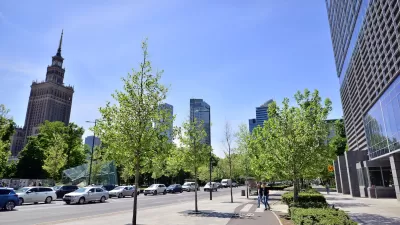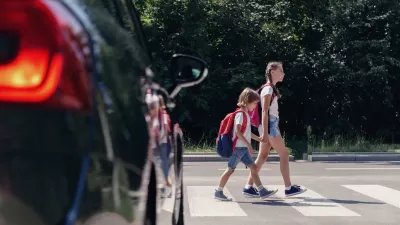Some transportation writers seem to believe that the interests of drivers and those of nondrivers are irreconcilable. For example, I just searched on google.com for websites using the terms “traffic calming” and “anti-automobile” together, and found over 60 such sites. But in fact, the interest of pedestrians in calmer, more walkable streets sometimes intersects (pun intended) with the interests of at least some motorists.
Some transportation writers seem to believe that the
interests of drivers and those of nondrivers are irreconcilable. For example, I just searched on google.com for websites using the terms "traffic calming" and
"anti-automobile" together, and found over 60 such sites. But in
fact, the interest of pedestrians in calmer, more walkable streets sometimes
intersects (pun intended) with the interests of at least some motorists.
In parts of my city, surface streets are eight or nine lanes
wide, and shops are typically set back at least a couple of dozen feet from the
street. Obviously, such streets are not
particularly safe for pedestrians. A
wide street takes more time to cross than a not-so-wide street, and every second
spent crossing streets and parking lots is another second that a pedestrian is
exposed to automobile traffic.
But does that mean that such wide streets are "pro-driver", and that critics of such street design are "anti-auto"? Not
necessarily. If you are a long-distance
commuter passing through an eight-lane street, you may think that the wide street is a good
idea, because it allows you to drive through the neighborhood more quickly.
But if you actually want to drive
to a shop or restaurant near the eight-lane street, you may find a narrower street more convenient. Suppose you want to drive to a restaurant on
the left side of the street. On a two-lane street, you don't have to worry
about getting into the appropriate lane to make a turn- you just get to the
store and turn left. But on an
eight-lane street, you have to plan your trip by getting in the center lane, and
then risk your life making a left turn across several lanes of high-speed traffic.
And if you don't know whether
your restaurant is on the left or right side of the street, Heaven help you,
because if you are driving 45 miles per hour to keep up with the traffic, you
probably won't be able to find your restaurant in time to figure out which lane
you need to enter. Ordinances requiring
buildings to be set back behind 20 or 30 feet of greenery or parking lots make
navigation even more difficult, because street numbers are often invisible when
buildings are far from the street.
Thus, decisions about street
design are not always simple "pedestrian vs. driver" conflicts; different
drivers have different interests. The
interests of a driver searching for a neighborhood destination, or of the
shopkeeper who wants to attract drivers to that destination, are not always the
interests of a driver who wants a speedy commute to exurbia.

Study: Maui’s Plan to Convert Vacation Rentals to Long-Term Housing Could Cause Nearly $1 Billion Economic Loss
The plan would reduce visitor accommodation by 25,% resulting in 1,900 jobs lost.

North Texas Transit Leaders Tout Benefits of TOD for Growing Region
At a summit focused on transit-oriented development, policymakers discussed how North Texas’ expanded light rail system can serve as a tool for economic growth.

Using Old Oil and Gas Wells for Green Energy Storage
Penn State researchers have found that repurposing abandoned oil and gas wells for geothermal-assisted compressed-air energy storage can boost efficiency, reduce environmental risks, and support clean energy and job transitions.

Private Donations Propel Early Restoration of Palisades Playground
Los Angeles has secured over $1.3 million in private funding to restore the Pacific Palisades playground months ahead of schedule, creating a modern, accessible space that supports community healing after recent wildfires.

From Blight to Benefit: Early Results From California’s Equitable Cleanup Program
The Equitable Community Revitalization Grant (ECRG) program is reshaping brownfield redevelopment by prioritizing projects in low-income and environmental justice communities, emphasizing equity, transparency, and community benefits.

Planting Relief: Tackling Las Vegas Heat One Tree at a Time
Nevada Plants, a Las Vegas-based nonprofit, is combating the city’s extreme urban heat by giving away trees to residents in underserved neighborhoods, promoting shade, sustainability, and community health.
Urban Design for Planners 1: Software Tools
This six-course series explores essential urban design concepts using open source software and equips planners with the tools they need to participate fully in the urban design process.
Planning for Universal Design
Learn the tools for implementing Universal Design in planning regulations.
Ascent Environmental
Borough of Carlisle
Institute for Housing and Urban Development Studies (IHS)
City of Grandview
Harvard GSD Executive Education
Toledo-Lucas County Plan Commissions
Salt Lake City
NYU Wagner Graduate School of Public Service






























